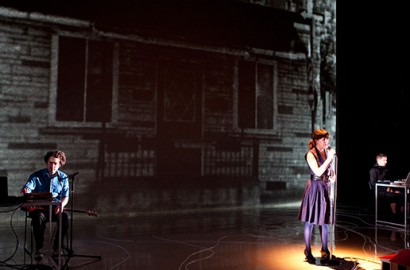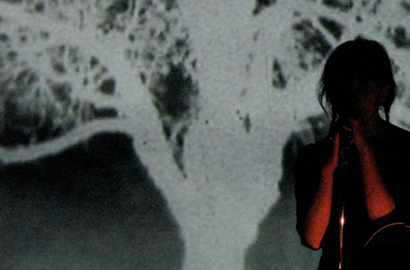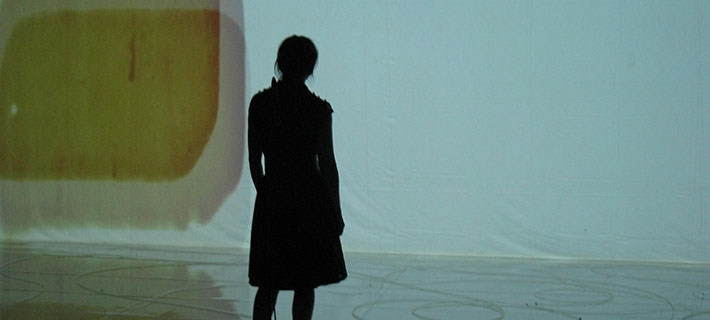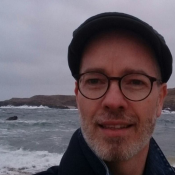If I were to sum up in a few words what I think Marie Brassard is doing in the theatre, I would say she is making the supersensuous sensuous. Through performance, and especially by exploiting the novel ways of seeing, feeling, and hearing that new media technologies enable, she encourages us to imagine worlds that lay beyond the incomplete reality we perceive with our limited senses: hers is a world of imagination.
The best way for me to introduce you to this imaginative aspect of her theatre, which I hope will act as an entrée into her work, and her play, Me Talking to Myself in the Future, is to describe two moments that encapsulate these ideas in her work, both gleaned from her second solo play, Peepshow.
In the first scene, Brassard plays a young girl – an age she partially effects by altering her voice through a microphone – who describes an experience she has had in school. Her teacher had shown her a flashcard on which a word was written, and she was asked whether the word was best categorized as a “person” or an “animal.” The word she was shown was “Dad.” The little girl decided that person was too simple and obvious and that this must be a trick question. “Maybe the teacher knows something I don’t and she’s going to show it to me,” the little girl muses. “Maybe she’s going to open a door to a world I don’t even know exists. And at the end of the day, I’ll be a better person.” With this in mind, the little girl responds, “Animal.” Disappointedly, her teacher told her that she was wrong, and relegated her to the side of classroom reserved for the “not-so-clever ones.” “The next day at school I understood the game,” she tells us, “and from then on, when I was asked a question, I’d answer the obvious answer. And everyone was happy, except for me. Because deep inside I knew I was right. I knew there must be a door somewhere.”
The second scene is more overt in its use of new media technologies, using both sound and video to extend the powers of both her performing body and our senses, literally providing us in the audience with the experience of seeing in the dark. In the scene, Brassard is lying on the floor, centre-stage, in the dark. We, in the audience, see her body projected on screen at the back of the stage, captured by an infrared camera mounted on the ceiling above her. On the screen, surrounded by darkness, her glowing body, in the yellow-green pixilated tones of the infrared video, floats like an apparition, or a celestial body. Her voice, like the previous scene, is mediated through a microphone and once again modulated to create the voice of the young girl, who, gazing upward, talks about the stars that fill the night sky. She speaks of the great distances between the stars, which we see her linking with her finger, creating the figures of men, women, and animals in a connect-the-dots style. Cleverly, she reminds us that the lights we see when we look into the night have most likely emanated from stars that have already burned out, which cease to live, though we nevertheless see their light in our reality, and make meaning of their shapes and existence. Suddenly, jarringly, the child’s voice transforms into that of a man, once again effected by audio manipulation. The scene concludes with the chillingly masculine voice, a presence that inhabits, perhaps violently, the femininely dressed body that we see on screen, singing I Put a Spell on You, whose lyrics of possession, love, and jealously, inspire eerily ominous and foreboding feelings.
Brassard founded her production company “Infrarouge” in 2001. It is dedicated to exploring, in her words, the “multi-media art of theatre” through the innovative use of sound, video, film, and lighting technologies, and through collaborations with “artists of diverse disciplines.” Since its founding, she and her collaborators have created six performances: Jimmy, The Darkness, Peepshow, The Invisible, The Glass Eye, and Me Talking to Myself in the Future.
Brassard’s theatre is informed by a process that, like the child in the first scene, explores the less obvious answer and makes it the key to unlocking the door to new theatrical realities that exist beyond our limited senses. In her theatre, which is a theatre of the imagination, which makes the supersensuous sensuous, we see things one cannot see with the naked eye, things that no longer exist, or never in fact existed. We see celestial bodies that talk, feminine bodies with masculine voices, and older bodies possessed by younger spirits. In each of her plays and performances, Brassard asks us to imagine worlds and realities that are beyond the fleshy capabilities of our senses. Her work is imbued with a spirit of youthfulness, creativity, experimentation, and, most importantly, imagination. It’s a theatre that believes in other worlds and dimensions and magic. It will put a spell on you, if you let it.
Marie Brassard’s Me Talking to Myself int he Future is on stage at Buddies from March 26 – April 6, 2014. Click here for info & tickets.
Related posts

Aurora Stewart de Pena on Me Talking to Myself in the Future



